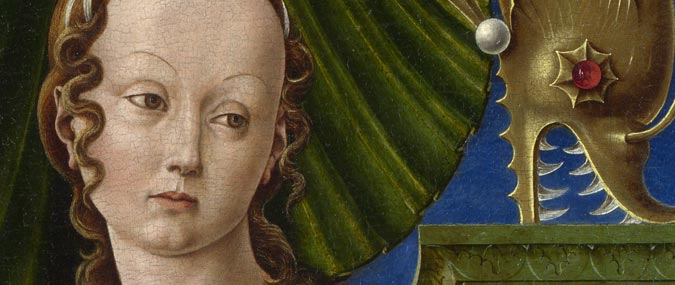The Entombment
Listen to David Bomford from the Conservation Department talk about The Entombment by Dirk Bouts.
Find out why paintings on linen, such as this one, are so rare today and why they are impossible to clean.
Art in the Making: The Entombment
Transcript
Female Voice: This painting by Dirk Bouts is painted on linen. As David Bomford, Senior Restorer of Paintings here at the National Gallery explains, the medium is pigments ground in glue. Surviving examples of this technique are extremely rare.
David Bomford: It doesn’t saturate the pigments as much as oil would do, although it’s now covered in dirt so it actually looks slightly dark. But originally it would have been very pale and dry-looking and the pigment is really just sort of clinging to the surface of the canvas in rather obvious particles. And this is a very vulnerable, a very delicate way of painting, and that’s the reason why so few of them have actually survived. Although in the 1450s-1460s when this was painted, there would have been many more of them than exist today.
Female Voice: At the time, oil paint was used only on wooden panels. Canvas was attractive because it was lighter and more portable. The pale, dry look was also similar to fresco paintings on walls, another familiar medium of the time.
David Bomford: What we’re seeing at the top edge of this picture is an area where it was originally turned around the edge of the wooden support, and so we see some old nail holes there. But we’re also seeing that the paint appears to be much lighter at that point because it was protected from the light and from dirt that settled on the surface. And so we’re seeing there the sky colour really much closer to how it would have appeared originally, and of course the dirt that we see all over the rest of the surface – it’s literally just, just dirt that’s come out of the atmosphere and has settled on the surface – and normally speaking if this was an oil painting you would just be able to wipe it off.
But because this paint is so delicate and because it’s ground in a glue medium which is soluble in water – you can’t wash it off because you’d wash the paint off as well – the paint is literally just clinging to the surface of the fabric. So any sort of cleaning process on this picture would be disastrous.
Female Voice: Bouts used four different blue pigments in this composition. The one used most in the background is indigo. It’s derived from plants and is particularly subject to fading.
David Bomford: The red of Saint John, the red robe, is pretty stable: it’s basically cinnabar, vermilion, red, probably mixed with a little bit of earth colour. And those are all stable colours; they’re not affected by light particularly, they retain their colour unlike the indigo that’s used elsewhere. But considering how fragile and how vulnerable this picture is, it is still in amazing condition considering that also so many of these paintings simply didn’t survive.
Next: A Muse (Calliope?)


